Traditional extraction process for BHT
In traditional follicular unit extraction FUE technique, 0.8-1.4 mm punch is used to cut the dermis to the level of attachment of erector pili muscle, so that the intact follicular unit grafts can be extracted. However, the larger extraction sites and higher hair root transection rates are some difficulties encountered while using the punch to extract body hair grafts. To overcome these difficulties, expanding needle concept has been devised. It approaches the extraction process by customizing the extraction wound to the architecture of the follicular unit and by performing most of the dissection of the dermal attachments to the donor follicular unit under direct magnified vision.
Follicular unit extraction using a hollow 0.8 -1.4 mm punch is a widely accepted technique of extracting scalp hair grafts. The resultant extraction wounds do not need suturing. This has been used to extract body hair grafts for transplanting to the scalp especially in people with extensive hair loss. However, the transection rates when extracting body hair using a hollow punch are higher than the scalp grafts. The use of expanding needle concept for extracting body hair grafts is a different extraction methodology in body hair to scalp transplantation. The expanding needle concept has overcome the difficulties of large extraction sites and higher transection rates faced in traditional follicular unit extraction method using a rigid punch.

Skin, in most body areas, is freely mobile over the underlying surface. The extraction is performed by using a rigid punch to cut around the follicular unit. The cutting of the tissue is done by the rotational motion of the punch. This results in torsion of the follicular unit due to this excessive laxity of the skin, leading to higher percentages of hair follicle transaction.
In the scalp donor area, the follicular units are very compact.

However, hair follicles in the body donor area follicular units may be spread out over 1.5 to even 2 mm. This necessitates larger diameter punches that leave larger extraction wounds giving rise to more visible scarring.
Hair follicles in most body donor areas lie at very acute angle. Therefore, in traditional punch method, the downward pressure of the punch causes damage to the follicular unit due to splaying of the roots as pressure is applied on the punch.
To overcome these difficulties using the traditional rigid punch method, a non-punch based body hair graft extraction technique has been devised.
Expanding Needle Concept (ENC)
In the expanding needle concept, the body donor area is shaved 3 -4 days before extraction. This helps identify the hair in anagen/growth phase. A hypodermic needle is used to perform the extraction. The needle tip is used as a cutting instrument in place of traditional rigid punch. The needle tip is used to first score around the follicular unit. Then, using a small tooth forceps to hold the top of the follicular unit, the tip of the needle is used to cut the adhesions of the follicular unit to deep dermal tissues and underlying fat under direct magnified vision. This dissection under direct vision ensures minimal transaction of the hair roots on one hand, and being able to extract a graft with surrounding fatty tissue (thus increasing graft survival rates) on the other.
Approach used in ENC for extraction of body hair grafts is described in the following way:
Advantages of using needle for extraction of body hair grafts:
Using needle tip for scoring and dissecting around the hair follicle of the body donor area hair grafts has certain advantages:
- The extraction of body hair grafts by a needle tip removes the need of rotary motion, thus removing the ill effects of torsion on the hair follicle.
- There is no significant downward pressure when using the needle as compared to when the punch is used. That reduces the transection rate of the hair follicle.
- Less damage to follicular units by scoring with needle, as the direction of the needle tip can be customized to the direction of emergence of individual hair follicle of the follicular unit.
- Smaller extraction sites (as the scoring around the body donor area hair graft can be customized as per the shape/lie of the individual hair follicles, and overall smaller extraction wound results).
- Major part of the extraction/dissection of the deep dermal adhesions is done under direct magnified vision. This improves the yield of the intact grafts from the body donor areas.
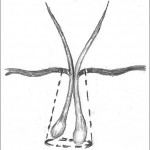
The extraction occurs as if the needle had expanded as it went inside, adjusting to the shape and diameter of the follicular unit
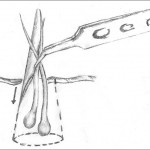
Needle tip is used to score around the follicular unit. 3 to 4 strokes are used to score around the entire circumference
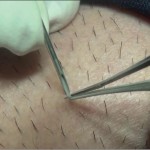
Extraction of follicular unit using hypodermic needle.

Needle tip is used to score around the follicular unit.
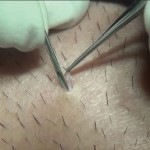
3 to 4 strokes are used to score around the entire circumference

The adhesions of the follicular unit to deep dermal tissue and underlying fat are cut by the needle tip under direct magnified vision
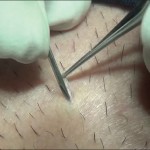
The tip of the needle is used to cut the adhesions of the follicular unit to deep dermal tissues
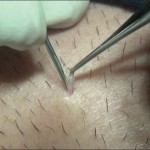
A small tooth forcep is used to hold the top of the follicular unit
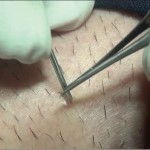
Needle tip being used to dissect dermal adhesions
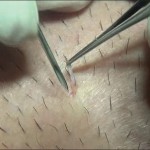
Needle tip being used to cut subfollicular fat

The follicular unit is extracted out using expanding needle concept with surrounding dermal and fatty tissue
Conclusion: Expanding Needle Concept
The use of the needle tip as a cutting instrument in the expanding needle concept is especially beneficial in the more difficult body donor areas, as it has reduced the difficulty posed by larger extraction sites and at the same time, lowered the transection rates of the body donor hair.
article written by Dr A. Poswal, New Dehli India
References:
- Rassman WR, Bernstein RM, McClellan R, Jones R, Worton E, Uyttendaele H. Follicular unit extraction: Minimally invasive surgery for hair transplantation. Dermatol Surg 2002;28:720-8.
- Poswal A. Body hair transplant: An additional source of donor, hair in hair restoration surgery. Indian J Dermatol 2007;52:104-5
- Poswal A. The preshaving protocol in body hair-to-scalp transplant to identify hair in anagen phase. Indian J Dermatol 2010;55:50-2
